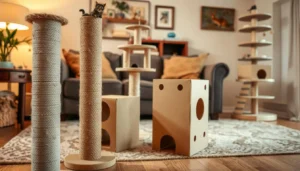Every cat owner has felt that sinking feeling when they see their expensive leather sofa torn apart by their cat’s claws. It’s not just about saving your furniture. It’s about understanding and connecting with your cat in a way that respects their natural instincts.
If you’re trying to stop your cat from scratching furniture, you’re not alone. Cats scratch for many reasons. With the right approach, you can change their behavior and still have a loving relationship. This guide will show you how to work with your cat’s natural tendencies, not against them.
Preventing cat scratching is definitely possible. With patience, understanding, and the right techniques, you can save your furniture and keep your cat happy and healthy.
Understanding Why Cats Scratch Furniture
Cat owners often wonder why their feline friends seem determined to turn furniture into their personal scratching posts. It’s important to understand why cats scratch. This helps in changing their behavior for the better.
Scratching is a natural and essential behavior for cats. It serves several important purposes:
- Maintaining claw health by removing dead outer layers
- Stretching their muscles and body
- Marking territory through visual and scent markers
Natural Instincts and Territorial Marking
Your cat’s scratching is deeply rooted in their instinctive behaviors. When cats scratch surfaces, they leave behind both visual marks and invisible scent markers from glands in their paws. This process helps them communicate with other cats and establish their personal space within your home.
Stress and Environmental Factors
Environmental changes can significantly impact a cat’s scratching behavior. New furniture, moving to a different home, or introducing a new pet might trigger increased scratching as a way of managing anxiety and establishing comfort.
Age-Related Scratching Behaviors
Different life stages influence cat behavior modification strategies. Kittens scratch to explore and develop muscle coordination, while senior cats might scratch more due to reduced mobility or cognitive changes. Understanding these age-related nuances helps you respond more effectively to your cat’s needs.
How To Stop Cat Scratching On Furniture: Essential Prevention Tips
To protect furniture from cats, you need a smart plan. It’s about understanding your cat’s scratching habits. This way, you can keep your home safe and your cat happy.
First, take care of your cat’s nails. Trimming them regularly can save your furniture. Try to clip your cat’s nails every two to three weeks. Use pet nail clippers that are easy and safe for them.
- Trim nails carefully to prevent splitting or breaking
- Use treats to create a positive nail-trimming experience
- Consider professional grooming if you’re uncomfortable doing it yourself
It’s important to give your cat a good scratching spot. Get a high-quality scratching post that fits your cat’s needs. Look for posts that:
- Are tall enough for full stretching
- Have a stable base to prevent tipping
- Offer different textures like sisal, cardboard, or carpet
Strategic placement matters! Place scratching posts near where your cat likes to scratch. This helps steer them away from your furniture.
The key to success is making the scratching post more appealing than your furniture.
Use cat-friendly deterrents like double-sided tape or covers to protect furniture. These can help while you teach your cat to scratch where they should.
Effective Scratching Deterrents and Solutions
To keep your furniture safe from cat scratches, you need a smart plan. There are many cat scratching deterrents out there. They help keep your home looking great and your cat happy.
Looking for ways to stop your cat from scratching? There are many good methods to change their scratching habits.
Commercial Sprays and Repellents
Professional cat scratching deterrents work well to save your furniture. Here are some good options:
- Citrus-based spray repellents
- Anti-scratch sprays with bitter apple essence
- Electronic scratch training devices
Natural Deterrent Options
Homemade cat scratching solutions are cost-effective and good for the planet. Try these natural options:
- White vinegar and water mixture
- Essential oil deterrent sprays
- Double-sided tape on furniture edges
Physical Barriers and Protective Covers
Use practical cat scratching solutions to protect your furniture. These create physical barriers:
- Furniture protector sheets
- Scratch guards
- Plastic furniture covers
Remember, being consistent is important when using these cat scratching deterrents. Each solution might work differently for each cat.
Creating a Cat-Friendly Scratching Environment
Understanding why cats scratch is important. It helps protect your furniture and keeps your cat happy. Cats scratch to stretch, mark territory, and keep their claws healthy. By offering the right scratching spots, you can guide their natural behavior.
When picking scratching posts, look for these key features:
- Sturdy base to prevent wobbling
- Height that allows full body stretching
- Multiple textures like sisal, carpet, or cardboard
- Placement near your cat’s favorite resting areas
Where you place scratching posts matters a lot. Cats like spots with good views and near where they sleep. Try both vertical and horizontal scratching surfaces to see what your cat likes best.
Make the new spots appealing with catnip or toys. Reward your cat for using the right spots. With time and effort, you can make your home a safe space for your cat’s scratching needs.
Training Techniques for Better Scratching Habits
Cat training techniques are key to managing your cat’s scratching. It takes patience, understanding, and strategies that fit your cat’s nature.
Start by understanding what drives your cat and setting up a positive learning space. Cats are smart and do best with gentle guidance and clear rules.
Positive Reinforcement Methods
Positive reinforcement is the best tool for cat training. Reward your cat with treats, praise, petting, or toys when they scratch the right spot.
- Tasty treats
- Enthusiastic praise
- Gentle petting
- Favorite toys
“The key to successful cat behavior modification is making the right behavior more rewarding than the wrong behavior.”
Redirecting Unwanted Behavior
To redirect your cat’s scratching, act quickly and calmly. If you see them scratching furniture, stop them and guide them to a scratching post.
Consistency in Training
Consistency is crucial in cat behavior modification. Make a routine that supports good scratching habits. Practice every day, knowing it takes time and patience.
With hard work, you can change your cat’s scratching habits. This way, you can keep your furniture safe and still have a great bond with your cat.
Common Mistakes to Avoid When Preventing Cat Scratching
Stopping cat scratching can be tough for many pet owners. Knowing the common mistakes helps protect your furniture better. It also keeps your relationship with your cat strong.
One big mistake is punishing cats for scratching. Cats scratch naturally, and punishment can make them anxious. It might even lead to more damage. Instead, use positive methods and give them the right scratching spots.
- Avoid physical punishment or yelling
- Never use spray bottles as a deterrent
- Skip removing claws or declawing
Another mistake is being inconsistent in training. Cats need clear, repeated signs to know where to scratch. Make sure to have a routine with many scratching posts and encourage their use often.
Many pet owners don’t figure out why their cat is scratching. It could be stress, boredom, or health issues. Knowing the reason helps you find better ways to stop it.
- Observe your cat’s scratching patterns
- Check for potential stress triggers
- Consult a veterinarian if behavior seems unusual
Lastly, don’t forget to make scratching posts appealing. Choose posts with different textures, heights, and spots. This keeps your cat interested in them, not your furniture.
Conclusion
Stopping cat scratching on furniture needs patience, understanding, and smart strategies. By using the methods from this guide, you can make your home better and keep your furniture safe. You can also keep a good relationship with your cat.
Cat scratching solutions are not about punishing them. It’s about changing their natural behaviors. Understanding your cat’s needs and giving them the right places to scratch makes a big difference. Every cat is different, so what works for one might need changes for another.
Begin with positive rewards, get good scratching posts, and stick to your training plan. With effort and time, you’ll have a peaceful home for both you and your cat. Learning to stop cat scratching is a journey of learning and growing closer to your pet.
Being proactive and knowing about cat behavior helps manage scratching habits. Stay patient, keep learning, and enjoy the great company your cat gives you.
FAQ
Why do cats scratch furniture?
Cats scratch furniture for natural reasons. They mark their territory, keep their claws healthy, and stretched. It’s a way for them to communicate, exercise, and keep their claws sharp.
How can I protect my furniture from cat scratching?
To protect your furniture, offer cats scratching posts and covers. Use deterrent sprays and keep their nails trimmed. Place scratching posts near where they like to scratch.
Are there any natural deterrents for cat scratching?
Yes, there are natural deterrents. Try citrus sprays, double-sided tape, or aluminum foil. Commercial sprays and essential oils like lavender or citronella also work, but use them safely.
How do I choose the right scratching post for my cat?
Choose a tall, stable scratching post made of materials your cat likes. Place it near where they scratch and make it interesting with catnip or toys.
Can I train my cat to stop scratching furniture?
Yes, you can train your cat. Praise and treat them when they use the scratching post. Redirect them to the post when they scratch furniture. Never punish them physically.
How often should I trim my cat’s nails?
Trim your cat’s nails every 2-3 weeks. This reduces damage and keeps their claws healthy. If you’re not sure, a vet or groomer can help.
What should I do if my cat continues to scratch furniture despite my efforts?
If your cat still scratches furniture, talk to a vet behaviorist. They can offer specific advice and help find the cause of the behavior.
Are there any medical reasons why cats might scratch excessively?
Yes, excessive scratching can be a sign of health issues. It could be skin problems, allergies, parasites, or anxiety. If your cat’s scratching is unusual, see a vet.



